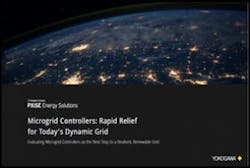Microgrid controllers are the next step to a resilient renewable grid
In this new white paper from PXiSE, the company explains how microgrid controllers can help utilities manage the challenges they face while they work to transition our electricity grid into one that is dynamic, resilient and able to take advantage of multiple DERs. Electric vehicles, solar, wind and battery energy will help utilities address climate change issues, but they also bring a new set of challenges for utilities.
According to the paper, “As the grid gets cleaner and serves a complex web of intermittent supply and demand requests, it is critical to maintain resiliency, provide affordable rates and enable a proliferation of customer DERs.” PXiSE says that microgrid controllers can help utilities manage the challenges they face during this transition, both at a lower cost and with less disruption to operations than they might expect.
The paper outlines six ways in which microgrid controllers can address grid challenges. They improve speed, accuracy and efficiency for utilities because they can “independently balance real and reactive power and efficiently dispatch resources for resiliency, power quality and economic benefit” in real time. Additionally, microgrid controllers allow grid operators to “reshape a load profile and optimize across a broader portion of the system.”
“If a utility is currently focused on better control of its own assets, improved integration of customer-owned assets and operates a grid that is experiencing strains from EV and DER adoption, then it presents a perfect use case for implementing microgrid controller solutions.” — PXiSE, “Microgrid Controllers: Rapid Relief for Today’s Dynamic Grid“
Microgrid controllers also stabilize intermittencies by keeping grid nodes in balance, reducing emissions, improving resiliency and promoting regulatory support.
The white paper presents the real-life case of Guam, which recently introduced microgrid controllers to its grid. PXiSE writes that “the controls used in Guam solve the intermittency issues caused by weather, effectively manage the existing renewable and legacy DERs, and create capacity for future DER additions.”
The paper also presents three key considerations for adopting microgrid controllers as a DER control strategy. Download this paper for free from the Microgrid Knowledge white paper library.








